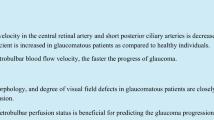Abstract
Purpose: To investigate the retrobulbar hemodynamic changes occurring in light and darkness in patients with early stages retinitis pigmentosa (RP). Methods: Eleven early stages RP patients were enrolled in the study. The peak systolic velocity (PSV), end-diastolic velocity (EDV), pulsatility index (PI) and resistivity index (RI) of the ophthalmic artery (OA) and central retinal artery (CRA) were measured by color Doppler imaging in light and darkness. The results were compared with that of 10 age-matched normal subjects. Results: PSV and EDV of the OA did not show significant differences in both groups. However, PSV and EDV of the CRA in RP patients decreased significantly in darkness (p = 0.001, p < 0.001, respectively). In addition, we found a significant increase in RI of the CRA in RP patients in darkness (p = 0.003). On the contrary, PSV and EDV of the CRA in control subjects showed a significant increase (p = 0.002, p < 0.001, respectively) and RI showed a significant decrease in darkness (p = 0.004). Conclusions: Darkness causes a decreased blood flow in the CRA in early stages of RP.
Similar content being viewed by others
References
Berson EL. Retinitis pigmentosa. Invest Ophthalmol Vis Sci 1993; 34: 1659–1674.
Li ZY, Possin BS, Milam AH. Histopathology of bone spicule pigmentation in retinitis pigmentosa. Ophthalmology 1995; 102: 805–816.
Grunwald JE, Maguire AM, Dupont J. Retinal hemodynamics in retinitis pigmentosa. Ophthalmology 1996; 122: 502–507.
Langham ME, Kramer T. Decreased choroidal blood flow associated with retinitis pigmentosa. Eye 1990; 4: 374–381.
Akyol N, Kükner S, Çeliker Ü, Koyu H, Lüleci C. Decreased retinal blood flow in retinitis pigmentosa. Can J Ophthalmol 1995; 30: 28–32.
Schmidt KG, Pillunat L, Kohler K, Flammer J. Ocular pulse amplitude is reduced in patients with advanced retinitis pigmentosa. Br J Ophthalmol 2001; 85: 678–682.
Cellini M, Lodi R, Possati GL, Sbrocca M, Pelle D, Guibilei N. Echo Doppler couleur dans la re´ tinopathie pigmentaire. Etude pre´ laminare. J Fr Ophthalmol 1996; 122: 502–508.
Wolf S, Po¨ stgens H, Bertram B, Chulte K, Teping C, Reim M. Hamodynamische befunde bei patienten mit retinitis pigmentosa. Klin. Monatsbl. Augenheilk 1991; 199: 325–329.
Cellini M, Santiago L, Versura P, Caramazza R. Plasma levels of endothelin-1 in retinitis pigmentosa. Ophthalmologica 2002; 216: 265–268.
Stone JL, Barlow WE, Humayun WS, de Juan E Jr, Milan AH: Morphometric analysis of vascular photoreceptors and ganglion cells in the retinas with retinitis pigmentosa. Arch Ophthalmol 1992; 110: 1634–1639.
Bill A, Sperber GO. Aspects of oxygen and glucose consumption in the retina: effects of high intraocular pressure and light. Graefes Arch Clin Exp Ophthalmol 1990; 228: 124–127.
Linsenmeier RA, Braun RD. Oxygen disribution and consumption in the cat retina during normoxia and hypoxemia. J Gen Physiol 1992; 99: 177–197.
Braun RD, Linsenmeier RA, Goldstick TK. Oxygen consumption in the inner and outer retina of the cat. Invest Ophthalmol Vis Sci 1995; 36: 542–553.
Havelius U, Hansen F, Hindfelt B, Krakau T. Human ocular vasodynamic changes in light and darkness. Invest Ophalmol Vis Sci 1999; 40: 1850–1855.
Riva CE, Grunwald JE, Petrig BL. Reactivity of the human retinal circulation to darkness: a laser Doppler velocimetry study. Invest Ophthalmol Vis Sci 1983; 24: 737–740.
Feke GT, Zuckerman R, Green GJ, Weiter JJ. Response of human retinal blood flow to light and dark. Invest Ophthalmol Vis Sci 1983; 24: 136–141.
Riva CE, Logean E, Petrig Bl, Falsini B. Effect of dark adaptation on retinal blood flow. Klin Monatsbl Augenheilkd 2000; 216: 309–310.
Author information
Authors and Affiliations
Corresponding author
Rights and permissions
About this article
Cite this article
Taner, P., Kara, S.A., Akarsu, C. et al. The Effects of Darkness on Retrobulbar Hemodynamics in Patients with Early Stages Retinitis Pigmentosa. Int Ophthalmol 25, 95–99 (2004). https://doi.org/10.1023/B:INTE.0000031743.67336.b5
Issue Date:
DOI: https://doi.org/10.1023/B:INTE.0000031743.67336.b5




